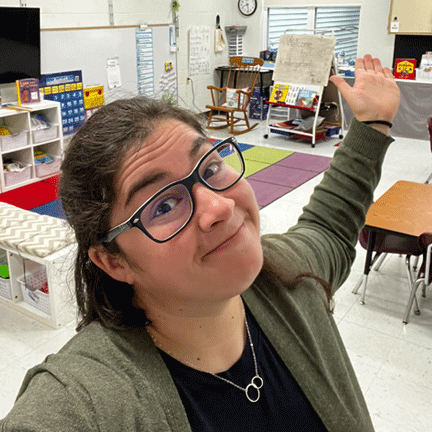Imagine a hard winter in the far north where the temperatures have dropped so low that recess is indoors. Now imagine an entire grade level of kindergartners playing in the hallways near their classrooms so their teachers can eat a duty-free lunch. The recess monitors are tattered. Emotions are running high for both students and recess monitors.
You are not a kindergarten teacher, but you hear them as you work on your computer during your own prep. Your door is open, and you enjoy hearing the variety of play happening. You’re grateful for the way the kindergarten team values different kinds of play.
Just then a screech echoes through the halls that makes goose bumps form instantly on your arms. You freeze. Something clatters on the windows in the hallway. Is it a fist? The wooden blocks? Kicking feet?
Chaos is brewing, and then a recess monitor’s whistle blows and a shrill voice shrieks above the commotion. You hear the demands for children to sit against the walls, knees up, arms crossed, and heads down. The pounding intensifies; it must be someone throwing the wooden blocks.
The silence is eerie, except for the clatter of blocks into the windows and a frustrated howl from a child.
You don’t know what to do. You want to help, because things are unraveling. As you step into the hallway, a kindergartner jets past. His howl is ear-piercing. The principal and guidance counselor are in pursuit. An all-call announcement is made throughout the building. The child is known to flee and hide. It can take hours to find him. The wind is brutal and snow swirls.
Before you can offer to help, the kindergarten teachers start moving their students into their classrooms. Recess ends early that day. The recess monitors are relieved; the classroom teachers cut their lunchtime short; the students missed out on a chance to relax during recess.
And you are left standing in an empty hallway wondering how the situation could have gone differently.
Here’s the thing: We don’t need to read about scenarios from elsewhere because we all have stories of extreme behaviors and crisis situations. Sometimes they involve students we work with directly; other times we are witnesses; frequently, we hear about the situation through the grapevine.
When something unbelievable happens with a student, educators often turn to their colleagues. Although this is a natural and potentially healthy move, it can also lead to tension and feelings of inadequacy. Often as the story is relayed, the listeners are appalled because, well, the situation is shocking. The common response is “This shouldn’t happen in schools; you shouldn’t have to deal with this.”
And then the blame begins….
- Blame the teacher for not managing the situation.
- Blame the administrator for not supporting the teacher.
- Blame the parents for not having firm boundaries.
- Blame the child for being attention-seeking.
- Blame yourself for failing.
We might not realize it, but often the adults who are directly involved in the situation blame themselves, feeling shame for not stopping the escalation, and questioning their ability to keep the student, themselves, and others safe.
What begins as innocently relaying a difficult situation turns into a storm of gossip and opinions that spread through a school, leading to more shame and blame. Sometimes this leads to educators quietly quitting, fueled by the faulty belief that what they know and do doesn’t make a difference. Other times it propels into a loud uproar amongst the faculty and staff. People who were not involved in the situation vehemently advocate for certain students to be “removed” or “punished” without having any idea of the whole picture or all of the factors involved in the decision-making.
If this rings true, know that you are not alone. More and more schools are facing complicated situations where it is impossible to meet the needs of everyone. Where do we even begin?
It will take time. First, our understanding of trauma influences the way we respond to a situation. If there isn’t a common vision for the way the adults in a school will respond to dysregulated behavior, then there will be a range of responses from colleagues to extreme situations.
Unfortunately, the common response people agree upon is “This shouldn’t happen in our school.” As people who have adopted several older children from foster care, we’ve had to learn to rid our minds of shoulds. Nothing fruitful comes from thinking about what should or shouldn’t happen.
We’ve experienced many situations in our own homes and schools that make us think, I can’t believe that happened. We’ve learned that the phrases I can’t believe that happened, and its cousin, This shouldn’t happen, are red flags, waving reminders that we are not dealing with logical and rational decisions but with trauma responses.
We must accept the situation as it stands without judgment. One of the first small steps to becoming a school community who works together to help students overcome extreme behaviors is to accept a situation without judgment.
This is not easy. We’ve had lots of practice within the walls of our own homes, and it still remains one of the most difficult mindsets to enact. When a situation escalates and the behavior becomes unbelievable, we must learn to believe the best in everyone involved.
- Believe the teacher used strategies to help the student be regulated for as long as possible.
- Believe the administrator knows more of the whole story and is making decisions to protect and honor everyone involved in the situation.
- Believe the parents are loving their child as best they can.
- Believe the child is connection-seeking.
- Believe you are enough.
Teaching is not for the faint of heart. We will face complicated situations that are almost unimaginable. We need each other in order to have the wherewithal to make a difference. It begins by believing the best in one another.
Resources
https://www.apa.org/news/press/releases/stress/2023/collective-trauma-recovery



